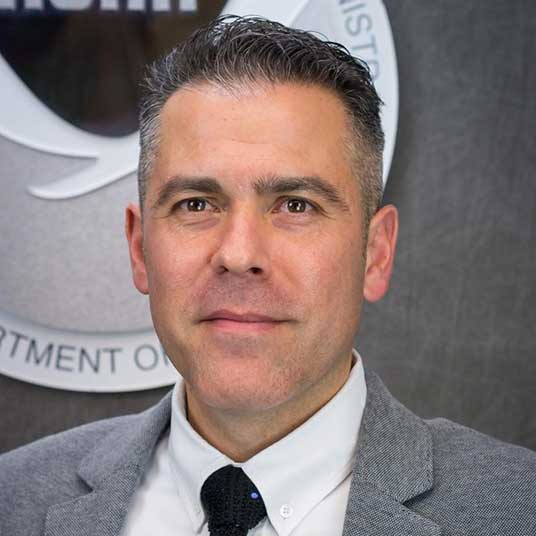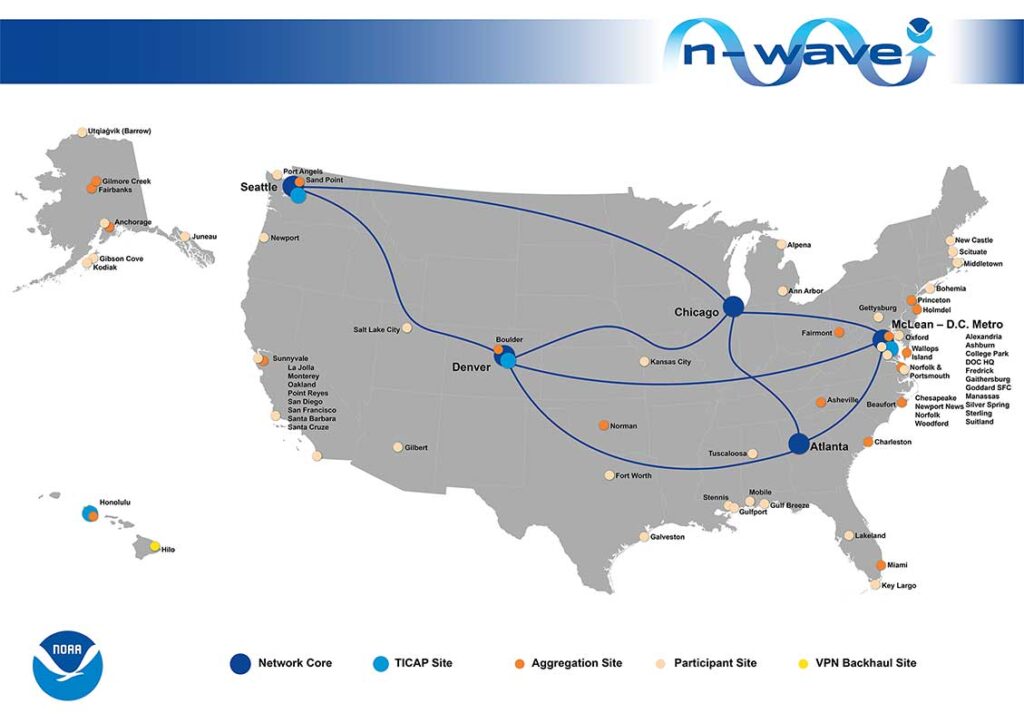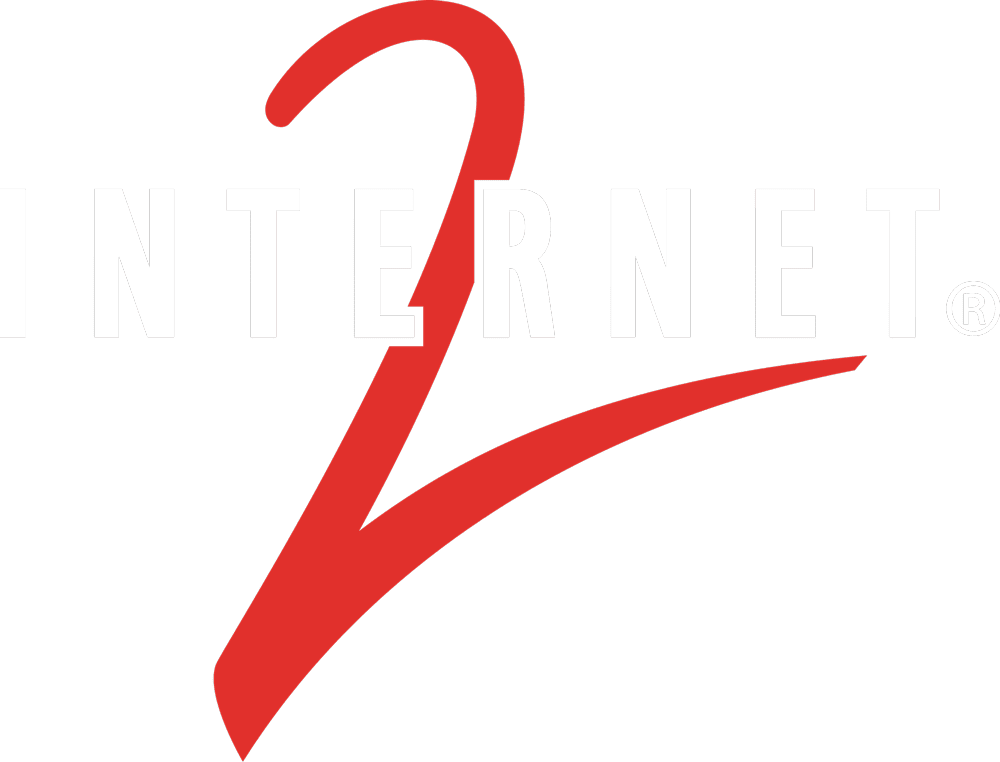31
January
2023
Q&A with Robert Sears: N-Wave Reaches New Milestones as an Innovative Mission Enabler in the Science Community
By Amber Rasche - Senior Communications Specialist, Internet2

Robert Sears is the director of N-Wave, the advanced, high-speed, and highly scalable network service provider operating from the National Oceanic and Atmospheric Administration’s (NOAA) Office of the Chief Information Officer. While it’s known as “NOAA’s Network,” N-Wave has expanded to serve multiple agencies in the U.S. federal government.
In this Q&A, Robert sheds light on the broad scope of N-Wave’s stakeholder community and services, and he discusses the role of community partnerships in fulfilling N-Wave’s role as a mission enabler. He also shares some recent capacity milestones for N-Wave’s national network backbone – including a major upgrade to 400 Gbps – and talks about how N-Wave’s cloud connectivity services support the data and cloud strategies of its diverse stakeholders.
Over the last 10+ years, many in the research and education (R&E) community have come to know N-Wave as “NOAA’s network,” delivering advanced, high-speed, and highly scalable network services in support of the vast and varied missions of the National Oceanic and Atmospheric Administration. Tell us about the true scope of N-Wave’s mission and stakeholder community today – in other words, who depends on your infrastructure and services?
Robert Sears: Generally speaking, N-Wave is NOAA’s network. Our program office operates under the NOAA CIO’s Office, and all six of NOAA’s Line Offices use N-Wave services: NOAA Office of Marine & Aviation Operations (OMAO), NOAA National Marine Fisheries Service (NMFS), National Ocean Service (NOS), Office of Oceanic and Atmospheric Research (OAR), National Weather Service (NWS), and the National Environmental Satellite, Data, and Information Service (NESDIS). But we’re also well-suited to support any government agency. That was one of the goals when we completed our 2017 Federal IT Investment Authority – that we could, through shared infrastructure and a shared service catalog, provide services to other federal agencies. We’ve definitely realized that opportunity for growth in the years since.
One of the most visible examples is our expansion to serve the wider U.S. Department of Commerce. There are 13 bureaus within the department, NOAA is one, and now 12 of the 13 bureaus and the Commerce headquarters in Washington, D.C., use N-Wave as their network service provider. This includes Trusted Internet Connections and wide area transport, along with the use of other services offered in our catalog.
Beyond Commerce, in partnership with NESDIS, we are optimizing the flow of NOAA data to specific Department of Defense (DOD) entities by placing N-Wave points of presence at various DOD locations. We are very excited about this interagency collaboration, which will ultimately support the betterment of critical weather forecasting at those locations.

Geographically, can you give us a high-level picture of N-Wave’s reach?
Robert Sears: Through N-Wave’s national network backbone, we provide connectivity at sites all across the contiguous U.S., and in Alaska and Hawaii. We are as far-reaching as Utqiaġvik, which is the northernmost city in Alaska, all the way down to the Florida Keys, and from Hawaii to New Hampshire. In total, we serve more than 100 stakeholder locations in cities across the U.S. It’s a pretty good swath!
We also connect to Europe leveraging the Advanced North Atlantic (ANA) collaboration, which includes Internet2 and GÉANT, to build virtual paths with the European Organization for the Exploitation of Meteorological Satellites (EUMETSAT) program. That partnership, which we call the JEUNO network or Joint EUMETSAT and NOAA network, enables NOAA and EUMETSAT to exchange weather satellite data and monitor the operational health of both organizations’ spacecraft.

Can you share some additional examples of how N-Wave’s infrastructure and services support your stakeholder community, especially in regions like Alaska where broadband infrastructure and access are limited?
Robert Sears: To give you an idea of the scope, our saying is N-Wave’s services and infrastructure support our stakeholder community from the campus to the cloud. N-Wave transport services – that’s the wide area network and Trusted Internet Connections – are the foundation of our portfolio. On top of that, we offer managed LAN, enterprise VPN, enterprise wireless, and firewall services. We also offer cloud transport services in partnership with Internet2 currently using OESS, which is evolving into the new Virtual Networks / Cloud Connect service that’s part of the Internet2 Insight Console.
One thing unique about N-Wave – and we’ve of course learned this from the communities we work with, including our state and regional R&E network partners – is that if there’s a drive for connectivity in a specific region like Alaska with a concentration of NOAA sites, we’ll go into the field and do the architecture, engineering, and design work to figure out the best way to accomplish it. In some cases, this involves working with local providers to pull new fiber to connect those sites. Or, in the case of a recent project within Alaska, we worked with Internet2, the Arctic Slope Telephone Association Cooperative (ASTAC), Alaska Communications (ACS), and AlasConnect to build a new N-Wave backbone interconnecting Anchorage to Fairbanks, Fairbanks to Seattle, and Seattle back to Anchorage. That backbone is a foundation for us to connect smaller offices in Alaska where geography and limited infrastructure combine to make stable, high-speed, cost-efficient connectivity a significant challenge.
What we’re creating is a shared infrastructure with higher bandwidth and lower costs, along with room for future growth. In phase one, we connected all major NESDIS and NMFS sites in Alaska with locations from Utqiaġvik to Kodiak to Juneau. Now we’re extending that connectivity to serve NWS sites, one of which is the National Tsunami Warning Center in Palmer, Alaska.
We use this approach in a lot of areas: is there a drive for enough offices, facilities, and science entities to come together and figure out how to best expand the network to serve a wider community? Another example is Sunnyvale, where we created an aggregation site to connect multiple NOS and NMFS offices up and down the California coast, including the San Diego pier where NOAA ships come into port. We’re trying to change the landscape for science missions by delivering high-speed connectivity where there’s limited or no access.
There’s a message that comes through every presentation and story about N-Wave regarding the value of its partnerships within the science, research, and education community. Can you tell us more about how those partnerships have played a role in building and expanding the N-Wave network?
Robert Sears: Those partnerships cover four of the key reasons why we built the N-Wave network: bandwidth, data delivery assurance, security, and cost. State and regional R&E networks face the same challenges we do. Our stakeholders have a lot of data to move either to the public or to other collaborators across the science, research, and education community, including universities and supercomputing facilities. Decades ago, it became apparent that the internet did not and will not have the required bandwidth and data delivery assurance to support critical, very large, regional- and national-spanning data transport needs.
Our R&E network partners built their own infrastructures because of the lack of bandwidth in their regions. And we leverage those to build the N-Wave infrastructure. For example, we partner with the Front Range GigaPOP to connect our Commerce site serving the National Institute of Standards and Technology (NIST), NOAA, and the National Telecommunications and Information Administration (NTIA) in Boulder, Colorado, to our network backbone in Denver; with Pacific Northwest Gigapop and Seattle city fiber to connect the NOAA Western Regional Center; and with the Corporation for Education Initiatives in California (CENIC) to connect NOAA sites in California. And, from those and other regional network partners, we connect to the Internet2 national network.
Those partnerships with regionals and Internet2 provide building blocks of bandwidth that’s not available commercially or, if it is, it’s extremely expensive. Visibility into the infrastructure is also built into our community’s fabric in a way that’s not possible through a commercial entity, as our partners share the understanding of their architecture, their fiber runs, and how their infrastructure is built. Visibility translates into security and operational stability – the more visibility you have into the design and architecture, the more you know about where you may need to engineer backup capacities or alternate paths. When you build your own network and know who you’re partnering with to move data across the country, you can control the data delivery assurance, too. You know it’s going to take x milliseconds from Colorado to Washington, D.C., and you know who to call if it doesn’t. And then you pull that all into a shared infrastructure within a community existing to proliferate science, research, and education, and the cost is much more efficient than buying commercial services to build something on that scale.
In the last few years, N-Wave’s national network backbone has reached new capacity milestones, including an upgrade to 100 Gbps in 2019 and an upgrade to 400 Gbps completed in 2022. What were some of the significant drivers behind those upgrades to boost N-Wave’s capacity and capabilities?
Robert Sears: N-Wave’s 100G national backbone served us well when our stakeholders needed multiple 10G connections to their sites. But we now have 100G or more at some sites, and the backbone has to support this demand. For example, the NOAA Research and Development High Performance Computing Systems office asked us to be prepared for increased data flows to the data center in Fairmont, West Virginia, where NOAA archives a lot of its operational supercomputing data and conducts HPC for weather research and development. This research driver prompted us to upgrade the Fairmont connection to our backbone from redundant 100G to redundant 200G. At the same time, we were looking to support more of the forecasting operations for the NWS at 100G, including the connection syncing NWS information dissemination sites in Boulder, Colorado, and College Park, Maryland, which house all the forecast data shared with the public. With these and other use cases, we started seeing a trend of more data traversing our national backbone.
We completed the 400G upgrade on the N-Wave backbone in the summer of 2022. It was a huge endeavor to achieve that next magnitude of bandwidth, and it took about a year with many moving parts. We installed all new hardware at our six core sites, established the 400G paths while maintaining our existing 100G paths, and then made the final transition of network traffic – all with zero downtime and zero interruption of the backbone availability. During that timeframe, we also continued to field requests for new services, including two new Department of Commerce sites and about a dozen NOAA sites.
N-Wave has been offering cloud connectivity services since 2017. Tell us about your team’s innovative work to develop and scale those services to support the cloud and data strategies of NOAA and the Department of Commerce. What are some examples of the use cases N-Wave’s cloud connectivity services now support?
Robert Sears: We operate and serve stakeholders within the federal government, so our cloud requirements are slightly different from most others in the R&E community. Because we have to maintain Trusted Internet Connections through a limited number of centralized gateways, or TICAPs, we use N-Wave connectivity – not the cloud service providers’ (CSPs) internet connections – to reach multiple CSPs. That includes Amazon Web Services (AWS), Microsoft Azure, Google Cloud Platform (GCP), and Oracle Cloud Infrastructure (OCI).
Since 2017, the N-Wave team has developed cloud transport services to meet those requirements and connect our stakeholder community to the cloud. Those services include cloud-based VPN tunnels, cloud broker circuits delivered as VLANs, and dedicated circuits. The VPN option is quick to deploy and best for smaller bandwidth connections – we can typically spin those up in less than a day. Our broker service is delivered in partnership with Internet2’s 100G Advanced Layer 2 Service (AL2S) and Cloud Connect to offer increased capacity at a lower cost. We’re actually one of the biggest users of Internet2’s Cloud Connect in terms of the number of circuits our team has deployed in support of our stakeholders’ missions – ranging in size from 1G to 5G. We’ve also leveraged a commercial provider for redundancy and to reach specific CSPs, like Oracle Government.
When we need 10G cloud connections, we use dedicated circuits. Most of the time, we do that with dark fiber or, in some cases, we use Internet2’s Rapid Private Interconnect. It’s as scalable with as much bandwidth as we can pull together on those shared connections, and then we provision them as needed. Currently, we have about 138 VPN connections, 124 virtual connections across those cloud brokers, and nine direct connections. It’s all done automatically through Internet2’s Cloud Connect interface – which has made for the rapid deployment and expansion of cloud connectivity for all our stakeholders.
In terms of use cases, the very first large dedicated connection we deployed was for NESDIS Operational Secure Ingest Service. The goal was for the NESDIS program to ingest satellite imagery from all over the world – including low-trust, moderate-trust, and high-trust sources. They would pull all that data into a secure, secluded AWS environment, then scrub it, validate it, and pipe it into NOAA for use and dissemination to other entities. So, in other words, we were leveraging the cloud as an isolated security measure for this data. We were also striving to get that ingest and scrubbing process to happen in real-time as much as possible, and that meant big network pipes.
Another example of a high-bandwidth dedicated circuit is our Comprehensive Large Array – data Stewardship System (CLASS), which is the program archiving all of NOAA’s satellite data. The data is downloaded to satellite ground stations in Wallops Island, Virginia, and Fairmont, West Virginia, and then it used to be archived at a facility in Boulder, Colorado. But that recently moved to the cloud. So now NOAA maintains a copy of all NOAA satellite data in Asheville, North Carolina, and in AWS, which also requires a big-pipe configuration.
Is there anything else you would like to share with the research and education community, including any other current or upcoming initiatives that you and your team are most excited about?
Robert Sears: A good amount of effort will be expanding our reach and influence in Alaska for the overall betterment of broadband access throughout the state. The Alaska region is one-fifth the size of the Lower 48 and, due to a number of challenging factors, the ability to service the state is restricted based on its sheer size, rugged terrain, and extreme environmental conditions. It’s a state where rural communities, local institutions, and agencies are vastly underserved by limited broadband access and network services. There are a wide variety and number of independent network initiatives in the state working to improve network and broadband access.
In an effort to provide a broader awareness of these projects, share ideas, and learn where opportunities may exist for partnerships and ways to leverage resources that can be shared, we’ve created an informal and completely voluntary consortium named the Alaska Region Technology Interchange Consortium (ARTIC). It consists primarily of federal and state agencies; the science, research, and education community; tribal nations; and other non-profit partners that can learn from each other by discussing member network needs and current opportunities/challenges, and by highlighting successful network/connectivity projects completed in Alaska. We are holding regular virtual meetings and plan to host an in-person meeting in Alaska this year. If other agencies or N-Wave stakeholders are interested in participating, they can reach out to me directly at robert.sears@noaa.gov.
